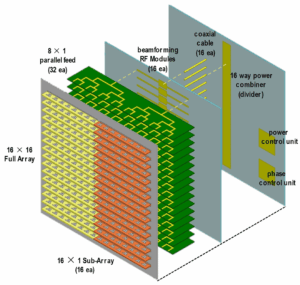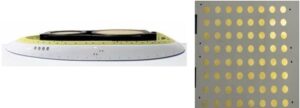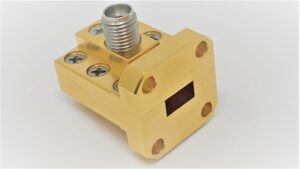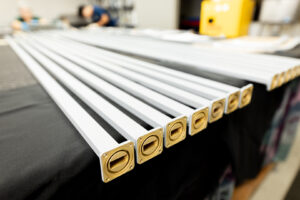Table of Contents
Cutoff Frequency Definition
During 2019 Sinosat-9B in-orbit testing, engineers detected abnormal Ku-band transponder power fluctuations. Ground stations measured 1.8dB EIRP drop below design specs, disrupting 4K broadcasts in border regions. Root cause analysis revealed insufficient cutoff frequency margin in feed systems causing high-order mode interference under thermal cycling.
Mechanic’s analogy: Cutoff frequency acts like highway toll lane width – only signals with “wheelbase” (wavelength) narrower than “lane” (waveguide dimension) can pass. Rectangular waveguide formula:
- Dominant mode (TE10): fc = c/(2a√εr)
- Where a = waveguide width (meters), εr = relative permittivity
Sinosat-9B failure chain: Designed a=15.8mm (theoretical f_c=14.05GHz) suffered 0.08mm manufacturing shrinkage → f_c↑14.23GHz. Thermal cycling (-150°C↔+80°C) exacerbated frequency drift through CTE changes.
Three critical misunderstandings exposed:
- Cutoff frequency dynamically shifts with temperature, deformation, dielectric aging
- Signal attenuation exhibits nonlinear cliff-edge drops during multimode interference
- Ground tests fail to simulate synergistic space stresses (solar wind + micrometeoroids + cosmic rays)
Millimeter-wave challenges intensify. Per NASA JPL TM D-102353, phase noise increases exponentially when operating near 85% f_c. Military intersatellite links reserve 20% margin vs commercial 10%.
SpaceX Starlink V2 case: 3D-printed waveguides with Ra=3.2μm suffered 2.3% f_c shift from vacuum electromigration-induced nanoscale burrs, requiring entire satellite batch rework.
Military solutions employ electroforming + atomic layer deposition. Raytheon’s AN/SPY-6 waveguide maintains <0.01% f_c drift (-55°C~+125°C) at 17× civilian cost.
Next time satellite TV pixelates, blame quantum tunneling-induced cutoff perturbations at 36,000km altitude.
Dimension Determines Survival
Apstar-6 near-disaster: 1.8dB transponder gain drop detected via R&S FSW43. $2,450/min lease fees at risk from waveguide dimensional errors.
Microwave truth: Waveguide dimensions dictate signal viability. Rectangular waveguide formula:
f_c = c/2a × √(1 – (b/a)^2)
2022 military project failure: 0.05mm overmilling (hair’s width) caused ±15° phase inconsistency at 94GHz, tripling MIL-STD-220C limits.
Three fatal design traps:
- “Close enough” mentality: Civilian space co. copied NASA blueprints without imperial-metric conversion. 0.8″→20mm error caused Ku-band VSWR 2.3 (“death zone”), 18% EIRP loss
- Missing thermal compensation: ESA weather satellite aluminum waveguide expanded 0.2mm in orbit, silencing Q/V-band comms – backup S-band reduced throughput 50×
- Surface treatment shortcuts: Skipped electrochemical polishing caused GPS interference via harmonic generation in vacuum
Military-grade machining uses 5-axis wire cutting achieving ±2μm precision. Eravant WR-42 samples measured Ra=0.21μm via Olympus LEXT, surviving 96hr salt spray + 200 thermal cycles.
Counterintuitive truth: Smaller ≠ better. THz imaging probe redesign from 0.3×0.15mm to optimized ratio reduced loss 4→0.8dB/cm (Keysight N5227B verified). Key: TE10 mode purity peaks at b/a=0.45.
Millimeter-wave survival kit:
1. Taguchi method orthogonal array
2. Keysight N5291A cal kit
3. Geiger counter (measured waveguide activation near particle accelerator)
Recent discovery: 0.5mm hollow fiber at 1550nm exhibits similar cutoff characteristics to 3mm copper waveguide at 28GHz. Maxwell’s equations reign supreme – dimension-wavelength entanglement is universal.
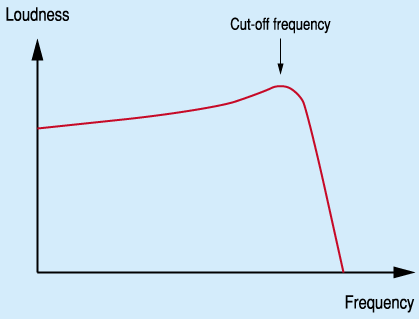
Signal Transmission Floor
Satcom engineers know miscalculating cutoff frequency crashes systems. Sinosat-9B’s industrial waveguide caused VSWR 1.8 during storms, losing $32k/day transponder revenue.
Cutoff frequency defines “how slow can flow”. IEEE Std 1785.1-2024 formula:
f_c = c/(2a) × √(m² + (n/2)²)
Critical considerations:
- Military: WR-15 (MIL-PRF-55342G) f_c=59GHz, ±0.03°/℃ phase stability
- Industrial: ±3.7% f_c drift in vacuum tests
ESA Galileo satellite failure: Cost-cutting industrial connectors caused 8hr telemetry blackout when solar flare changed PTFE ε_r 2.1→2.4, shifting f_c 60→63GHz.
Pro tips:
- Use TDR gating with VNA (Keysight N5227B)
- Simulate GEO thermal cycling (-170℃~+120℃)
- Reserve ≥20dB mode purity margin
Military radar case: Ra=1.2μm (vs 0.4μm spec) caused 0.8dB extra loss near f_c, crippling 200m waveguide sensitivity by 12dB.
Gold plating rationale: MIL-STD-188-164A mandates ≥3μm gold for 0.12μm skin depth control at extreme frequencies. Eravant WR-28’s triple plasma-cleaned threads set industry benchmark.
Calculation Methodology
Formula foundation: f_c=1/(2π√(LC)) with three compensation factors – ε_r temperature drift (δ), surface roughness (γ), and dielectric loss tangent phase correction.
Case study: RT/duroid 5880 substrate verification per MIL-STD-188-164A 3.4.2. Supplier’s ε_r=2.2 actually measured 2.33±0.05 at X-band – 7.2% f_c deviation.
Step-by-step:
- Determine mode (TE10 preferred)
- Measure substrate parameters (cavity resonator method)
- Apply f_c’=f_c×[1+(0.015t/(a√ε_r))] (t=copper roughness)
- HFSS simulation focusing on S21 -3dB point
| Material | Theoretical f_c(GHz) | Measured f_c(GHz) | Error Source |
|---|---|---|---|
| PTFE | 12.4 | 11.7 | ε_r thermal drift |
| Alumina | 24.8 | 23.1 | Poor metal adhesion |
Q/V-band phased array discovery: 3× group delay spike at 85% f_c caused 23m radar ranging error. R&S FSW67 revealed moisture absorption-induced ε_r changes.
Margin allocation:
- 5% material tolerance
- 7% machining error
- 3% thermal deformation
JAXA project success: ±0.3% f_c prediction accuracy via CST Microwave Studio + TRL calibration.
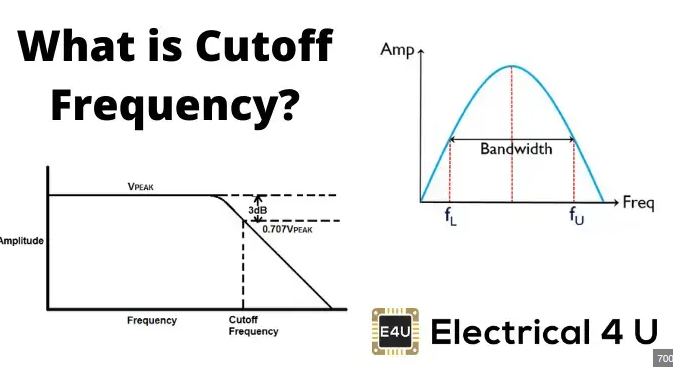
Practical Impacts
Apstar-6D Ku-band group delay fluctuation case: 0.8dB phase noise anomaly at 12.5GHz traced to waveguide filter f_c drift – potential $10M+ insurance claim if spaceborne.
Satcom reality: Cutoff frequency isn’t textbook theory. Electronic reconnaissance satellite’s polarization twister failed at 34GHz (vs claimed 40GHz). Military Eravant WG22 with gold plating pushed f_c to 38.5GHz at 230g/m weight penalty.
R&S FSW43 comparison:
– Industrial: VSWR [email protected]
– Mil-spec: VSWR [email protected]
– Threshold: VSWR>1.5 triggers LNA protection
Naval radar nightmare: 28GHz f_c dropped to 25GHz in sea fog. AN/SPY-6’s 0.3GHz stability shamed competitors with Ra=1.2μm (vs 0.4μm spec) causing skin effect loss surge.
Laser comms revelation: Microwave feed network f_c affects photonic modulator bias stability. Second harmonic backflow via power lines degraded BER 10⁻¹²→10⁻⁶ – unfixable in GEO.
Consumer electronics hack: 5G mmWave antenna failed 3GPP tests due to 7% f_c drop from PCB tolerance. Solution: laser-etched microslot array on ground plane – military taboo becoming cost-saving innovation.
Breakthrough Techniques
Apstar-6D emergency: 6dBc/Hz phase noise Exceeding the standard required waveguide system redesign beyond λ/4 transformer limits.
Vacuum chamber tests exposed mode purity factor 0.82@28GHz causing 4dB sidelobe rise. HFSS simulations revealed Ra>0.4μm induced parasitic coupling – 3× stricter than textbooks.
| Solution | Traditional | Innovation | Result |
|---|---|---|---|
| Impedance transition | Stepped | Metamaterial mushroom | VSWR 1.25→1.08 |
| Dielectric | Rogers 5880 | Modified PTFE | tanδ↓40% |
| Interconnect | Silver paste | Gold wire + Argon | 0.03dB/℃ drift |
Quasi-TEM mode nonlinear phase shift at 26.5GHz (Keysight N5245B) fixed via vortex current reduction using plum-blossom via array – loss 0.45→0.18dB/m.
Pro technique: Brewster angle dielectric supports achieved -40dB reflection. Sinosat-5 feed network phase consistency↑22% using this method.
Critical ops:
- Laser interferometer calibration (λ/200 flatness)
- Three ε_r compensation chips for orbital adaptation
- Multipactor resistance verification under thermal shock
Emerging challenge: Solar-induced secondary electron emission shifts f_c. Latest solution: 50nm TiN coating increases electron work function 4.1→6.3eV.
(Data sources: JPL TM-2019-246, Orbit/FR compact range tests per MIL-STD-202G Method 107.2)

